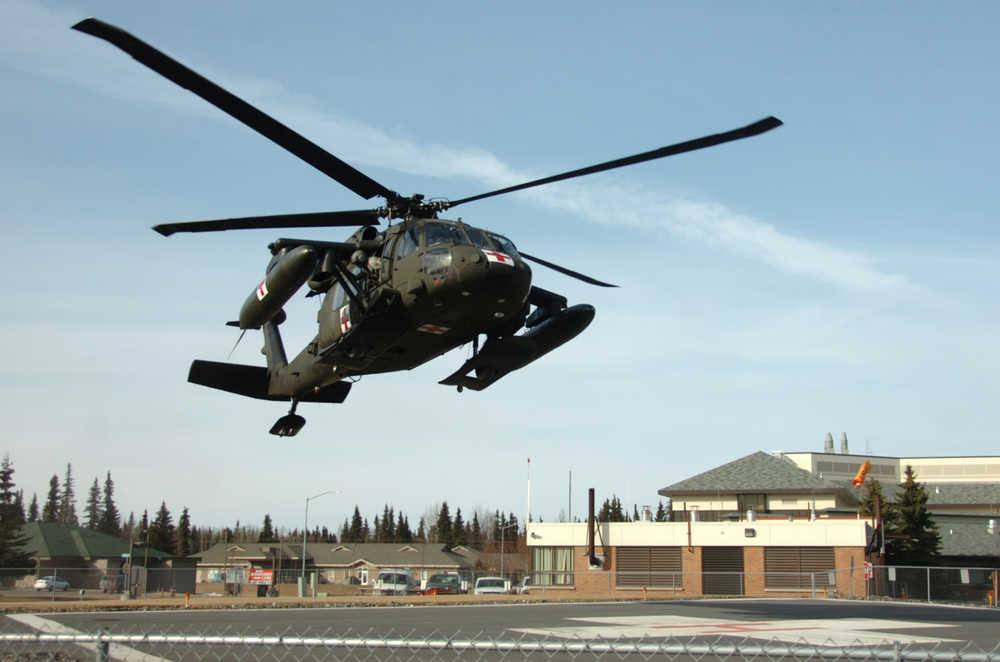Editor’s note: This story has been changed to correct the names of Captain Bill Keller and Central Peninsula Hospital external affairs manager Bruce Richards, and to identify the Black Hawk helicopters involved in the exercise as Army vehicles.
A landslide in Homer damaged the region’s power infrastructure and roads, leaving Homer’s South Peninsula Hospital without electricity or ground vehicle access. The disaster required South Peninsula patients, as well as incoming trauma victims, to be transported by helicopter to Soldotna’s Central Peninsula Hospital. These victims, fortunately, were inflatable rubber dummies, and the landslide existed only within the scenario of a three-day disaster preparedness drill for the two hospitals.
Dan Nelson, program coordinator at the Kenai Peninsula Borough Office of Emergency Management, said he began helping the state Department of Health and Social Services plan the drill several months ago, and that the scenario was “potentially a very realistic one.”
“Most of our communities have one road in and one road out,” Nelson said. “So in this scenario, that landslide took out part of the Sterling Highway… Look at what that effects. We have the city of Homer. But we also have all that infrastructure out on east-end roads… This affects Seldovia, Port Graham, Nanwalek. So it was a really good scenario for us, because as we’ve seen in the past, with avalanches in the early 2000s, it was pretty realistic.”
Central Peninsula Hospital external affairs manager Bruce Richards described CPH as a “bit player” in the drill, the main action of which happened with medical and emergency services on the south peninsula. Nonetheless, he said the drill gave CPH an opportunity to practice its “code black” procedures — the hospital’s term for a large influx of patients in a short time.
“We’re just receiving the patients and kind of letting off the relief valve for (South Peninsula Hospital),” Richardson said.
“It’s good exercise for us, and it’s something we drill annually anyway. This is a bit more than we normally do, so it’ll be something to receive all these helicopters here. It’ll test our emergency department to take this patient surge, he said.”
The first patient arrived from Seldovia in an Army Black Hawk helicopter on Friday around 1 p.m. His simulated condition was bone-fracture and internal compression injury as a result of flipping his four-wheeler. Seven other patients arrived throughout the day, though they were dummies rather than human volunteers. Although planners originally intended to use volunteers in makeup as simulated patients, Captain Bill Keller, who coordinated two Black Hawk helicopters from Fort Wainwright’s 1st Batallion, 52d Aviation Regiment in the exercise, said that legal issues prevented civilian volunteers from riding in Army helicopters. The Seldovia patient was a member of the National Guard.
The patient was brought into the hospital’s triage area with a card describing his mishap, and the staff went through the procedure of diagnosing and treating him. He was given a simulated CT scan of his head and chest, an electrocardiogram, and a chest x-ray. After diagnosis and simulated treatment with pain medication, the staff concluded that in a real situation they would have sent him to Anchorage for further care.
“We did not actually put him through (the diagnosis and medication),” said nurse Rachael Verba. “We simulated how we would have put him through those, to make sure our process for a mass drill like this does go smoothly, to make sure that the teams need to know what happens next… We played along with it, as though it were the real thing, so if we really do get serious situations, the first time we do it isn’t on a real person.”
By the end of Friday’s exercises, CPH had received eight patients in three flights. Captain Keller said that three National Guard and two Air Force helicopters participated in the operation.
“They (the National Guard helicopters) were helping move some of the cargo and passengers back and forth from Anchorage to Homer, whereas we were primarily responsible for patient evacuation,” Keller said.
Keller, a 2002 native of Soldotna, was able to see friends and family members while on the ground at Central Peninsula Hospital. For the rest of his crew, the mission was also an opportunity to interact with the public. “For some of them, supporting civil authorities is absolutely a brand new endeavor,” said Keller. “Of course most of us are the product of recent operations overseas, and now we are really getting back into the core mission-set of being able to respond to domestic disasters and emergencies, which is something we’ve not been able to do a lot of due to our operational tempo over the last 10 years. It is absolutely a thrilling change for us in that we get to get out and help our local communities and meet the people that support us and give back in that way.”
The drill, which began on Thursday afternoon and finished its exercises Saturday, will conclude with meetings and debriefings on Sunday. Nelson said that the borough, the hospital, and the other agencies involved will use the evaluations and observations made during the drill to revise their emergency plans.
“These exercises are designed to test our systems,” Nelson said. “One important thing that a lot of people misconstrue is that we’re testing people… That’s not actually what we’re doing. We’re testing our systems, not people. How are we able to set this framework up so we can interface with the borough, with the military, with the state, with all those various aspects?”

